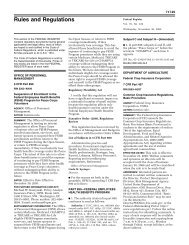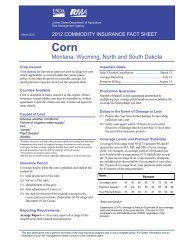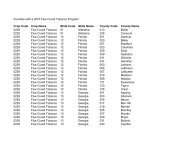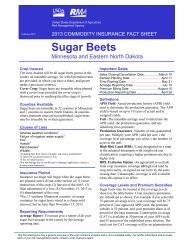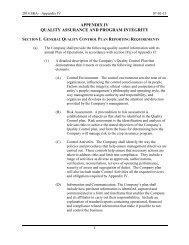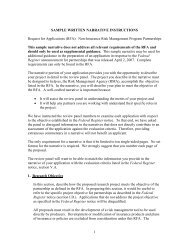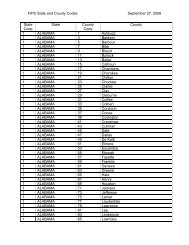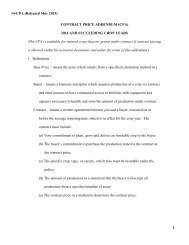Feasibility research report for insuring commercial poultry production
Feasibility research report for insuring commercial poultry production
Feasibility research report for insuring commercial poultry production
Create successful ePaper yourself
Turn your PDF publications into a flip-book with our unique Google optimized e-Paper software.
Production is impacted by the competence of both the grower, who deals with day-to-day care ofthe flocks, and the integrators who control feed, stock quality, and other major managementstrategic decisions. 19 Under the contract system, <strong>poultry</strong> growers give up much of the control of<strong>production</strong> and marketing decisions in return <strong>for</strong> what is effectively a ―price guarantee.‖ Withpayments to growers from integrators based on relative <strong>production</strong> per<strong>for</strong>mance, the common<strong>production</strong> risks are transferred from individual growers to integrators. By some estimates, morethan 95 percent of the risk is shifted from contract growers to integrators through the typicalcontract arrangement. 20 Growers can affect <strong>production</strong> through management decisions, but theseactions are not technically risks as they are defined in the insurance context and certainly are notinsurable. Nonetheless, growers express concern about contracts with tournament pricing, wheretheir payment is influenced by their neighbors‘ per<strong>for</strong>mance. They believe outcomes can bebiased through stock quality and other <strong>production</strong> inputs, all generally under the control ofintegrators. However, the grow-out contracts may provide growers some risk managementthrough casualty clauses that compensate <strong>for</strong> losses arising from natural disasters such as a flood,excessive heat, fire, or ―losses of potential <strong>production</strong>.‖ 21It is relative <strong>production</strong> outcomes, not actual outcomes, that most affect grower income. Nogrower experiences a lower per pound payment when all growers experience an unfavorable(systemic) <strong>production</strong> outcome. Consequently, growers do not bear the common systemic<strong>production</strong> risk. If, <strong>for</strong> example, unfavorable weather reduces all growers‘ settlement costs, nogrower receives a higher or lower per pound payment. Growers bear only the idiosyncraticportion of <strong>production</strong> risk, which in turn is influenced primarily by management practices.Integrators control most of these practices, while growers control a limited portion which appearsto vary somewhat by the terms of particular contracts. 22Price RiskBoth <strong>poultry</strong> (output) prices and feed (input) prices are subject to market <strong>for</strong>ces. Together, risksassociated with prices can result in considerable variability in the economic situation in the<strong>poultry</strong> industry. However, output and input price changes do not directly and immediatelyaffect the <strong>poultry</strong> grower. Under the terms of most contracts, stock price, feed price, andveterinary cost variability do not directly enter into the grower‘s net revenue variability. Theseare either paid by the integrator or fixed in the contract. Grower payments depend on <strong>production</strong>outcomes (weight of output) but not generally on price of either material inputs (except energycosts) or output prices. Consequently, growers in general do not experience direct price risk.Price risk is transferred from growers to integrators under the two-part tournament contracts.Integrators, whose operations are almost always well-diversified, can manage much of their inputprice risk through financial instruments and long-term contracts. However, no third-partyexchanges offer futures contracts <strong>for</strong> <strong>poultry</strong> products. As a result, output price risk is bornealmost entirely by the integrators.19 Ibid.20 Knoeber, C. R. and W. N. Thurman, 1995, ―Don‘t Count Your Chickens…,‖ Risk and Risk Shifting in the Broiler Industry.American Journal of Agricultural Economics. pp. 486-496.21 USDA, ERS, Bulletin 748, 1999, p. 13, http://www.ers.usda.gov/publications/aib748/aib748c.pdf, accessed April, 2010.22 Taylor, C.R. and D. A. Domina, 2010, Restoring Economic Health to Contract Poultry Production,http://www.dominalaw.com/ew_library_file/Restoring%20Economic%20Health%20to%20Contract%20Poultry%20Production%202010.pdf, accessed May, 2010.Use or disclosure of in<strong>for</strong>mation or datacontained on this sheet is subject to therestrictions on the title page of this <strong>report</strong>.13Risk Management AgencyContract No: N10PC18148



